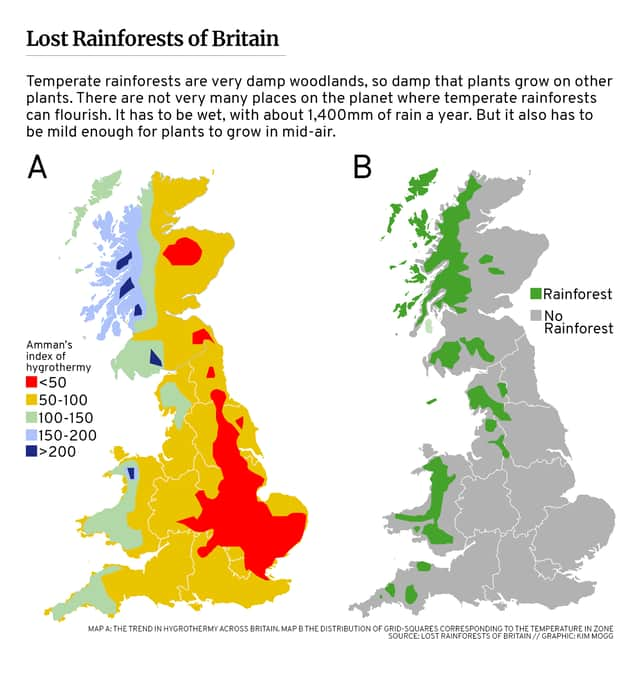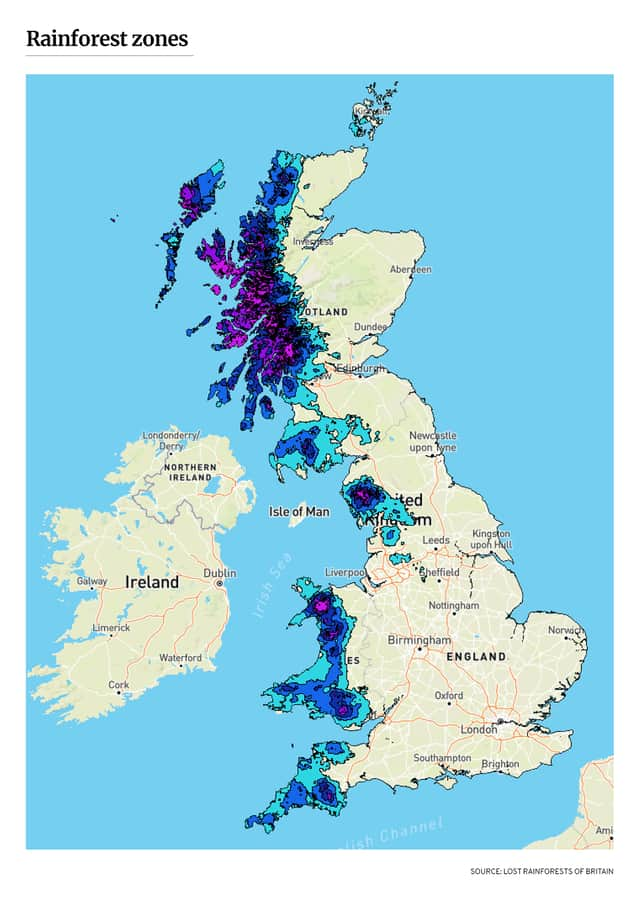Temperate rainforests in Wales and Isle of Man to be restored to recover ‘gorgeous habitat’
and live on Freeview channel 276
A programme to increase rainforests in the British Isles has been launched to restore the “gorgeous habitat” which now covers less than 1% of the islands.
Two sites have been named as the first places for the Atlantic rainforest recovery programme, benefiting from a £38 million scheme to help the rare habitat recover. The Isle of Man's Creg y Cowin and Bryn Ifan near Wales' Llyn Peninsula will be the first sites worked on by the Wildlife Trusts (WT).
Advertisement
Hide AdAdvertisement
Hide AdTemperate rainforests, also known as Atlantic or Celtic rainforests, are found in places with exposure to the sea – areas with “high oceanicity” – and receive high rainfall and humidity, with a low variation in annual temperature. It is a globally rare habitat, full of rare plants, lichens and fungi, and they are thought to be more threatened than the tropical rainforest.
They have mostly been destroyed by agriculture and development over hundreds of years. At Creg y Cowin on the Isle of Man, more than 28 hectares (70 acres) will be planted with native tree species, and eight hectares will be allowed to regenerate naturally.


The Manx Wildlife Trust will also look after non-planted areas such as lowland heath, fen-meadow, waxcap grassland and ponds, to provide a mosaic of habitats for wildlife. They will use conservation grazing in some areas to maintain diversity of habitat.
The organisation added that it hopes the area, which was currently being used as agricultural land, would eventually see the return of birds such as wood warblers, pied flycatchers and redstarts. At Bryn Ifan, Gwynedd, the North Wales Wildlife Trust will plant 40 hectares of rainforest on Bwlch Mawr, the mountain overlooking Bryn Ifan.
Advertisement
Hide AdAdvertisement
Hide AdIt will use native planting as well as natural regeneration to boost temperate rainforest. While some areas will be dedicated to nature-friendly farming, conservationists will also improve nearby wetlands to help rare species such as the marsh fritillary butterfly.
Tree species will include oak, birch and alder, and the area will be managed by conservation grazing. WT's Rob Stoneman said the areas would provide vital habitat and store carbon.
Manx Wildlife Trust's Leigh Morris said the remnants of ancient woodland on the island were "crucially important" and it was "fantastic" the island would now be in "the vanguard of bringing temperate rainforests back on a big scale". Mr Stoneman said the sites would "provide vital habitat for wildlife in a time of nature crisis, store vast amounts of carbon, and benefit local communities for generations to come".
He added: "Restoring this gorgeous habitat will also allow adaptation to climate change, reduce threats from extreme heat, flood and drought, and enable local people to reap the benefits.”


Where are British rainforests?
Advertisement
Hide AdAdvertisement
Hide AdThe Lost Rainforests of Britain campaign works to map and restore Britain’s lost rainforests.The map shows both Britain’s rainforest zone and fragments. The rainforest zone is where the climate is sufficiently rainy and mild for temperate rainforest to thrive. This region covers around 20% of Britain.
This map shows that more than half of Wales and nearly all of western Scotland, as well as large parts of Cornwall, the Lake District and other pockets north of Manchester, have suitable climates for temperate rainforest. Areas where rainforests currently exist in Britain include Cornwall, Wales, the Lake District and the west coast of Scotland.


How to spot them in the UK
In the Tropics a rainforest is somewhere wet enough for the trees to have other plants growing on them. You can look for similar clues for rainforests in cooler climates. Epiphytes, plants that grow on other plants, are the key indicator. The key is abundance. Anywhere wet enough to host a mass of lichens, mosses and fungi is a likely candidate.
- Beefsteak fungus (Fistulina hepatica): resembles a slab of raw meat and complete with dripping blood. It thrives on oaks in both dry woodlands and rainforests.
- Octopus suckers (Collema fasciculare): a type of jelly lichen found in the rainforests of western Scotland.
- Hazel gloves fungus (Hypocreopsis rhododendri): found only on decaying branches of rare hazelwoods on the Atlantic coast.
- Lobaria virens: a green, shiny lichen marked by orange disks, thrives in the dampest parts of the Lake District, Wales, Scotland and the West Country.
Why should Britain’s rainforests be protected?
Campaign lead Guy Shrubsole said on The Lost Rainforests of Britain website, that “Britain is home to such a globally rare habitat” which “few people realise”.
Advertisement
Hide AdAdvertisement
Hide AdHe said: “Unfortunately, our temperate rainforest only remains in fragmented pockets, but this doesn’t have to be the case. The best way to bring back the lost rainforests is to better protect what we have left, and then allow these rainforests fragments to expand and regenerate naturally."
Lee Schofield, Wild Haweswater site manager, said temperate rainforests in Britain are “the jewels in the crown of the UK’s natural heritage, yet they face multiple threats.”
He added: “Over the coming decades, rainforest will begin feathering back up onto the fells, creeping out from gorges, spilling down from ledges, spreading from the refuges where they have been waiting for our relationship with nature to change.”
The Department for Environment, Food, and Rural Affairs recently announced its £30 million Big Nature Impact Fund to back efforts to “support and expand England’s temperate rainforests.” However, The Lost Rainforests of Britain are still waiting for more details on the specifics of the funding and how much will be allocated for rainforest restoration and protection.
The government has previously said that much of the country’s temperate rainforest is protected and that it is committed to its safekeeping.
Comment Guidelines
National World encourages reader discussion on our stories. User feedback, insights and back-and-forth exchanges add a rich layer of context to reporting. Please review our Community Guidelines before commenting.
